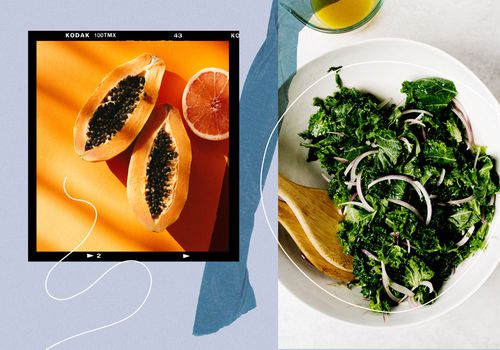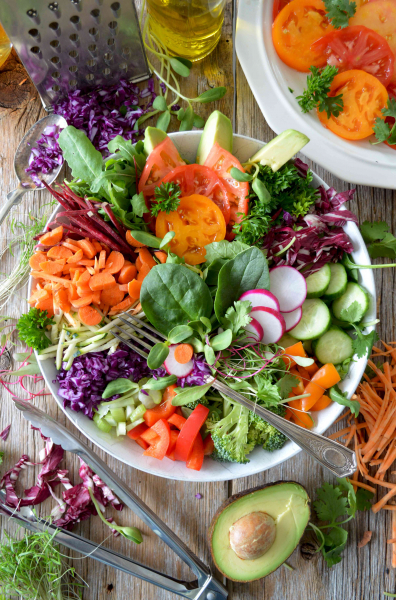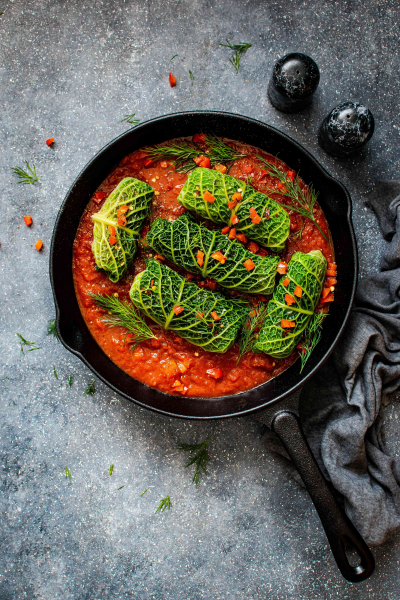
Detoxing usually involves cutting out certain food groups, but before you commit to a liquid-only diet for seven days, consider a different type of cleanse: the microbiome diet. Natural health enthusiasts swear this anti-inflammatory food plan can help with skin a host of health concerns from acne to depression by rebalancing the bacteria in your digestive system in just a few weeks—no juicing required. Read on to learn everything you need to know about the microbiome diet and whether it really works to restore your gut health.
Meet the Expert
- Daniela Turley is a medical herbalist with practices in New York and London. Turley sits on the board of The American School of Natural Health and is a member of The American Herbalists Guild and The College of Practitioners of Phytotherapy.
- Rachel Nazarian, MD is a board-certified dermatologist and fellow of the American Academy of Dermatology who specializes in cosmetic treatments, skin cancer, and dermatologic surgery.
- Brigid Titgemeier, MS, RDN, LD, IFNCP is a functional medicine registered dietitian nutritionist and health advocate, on a mission to transform people’s health and change their lives through personalized nutrition.
What is the Microbiome Diet?
The microbiome diet is a three-phase eating plan created with the goal of helping people restore gut health and lose weight. The diet was created by Raphael Kellman, MD, who developed the program based on his work with patients in his practice, the Kellman Center for Integrative and Functional Medicine. The diet was popularized by his 2014 book titled The Microbiome Diet.
Kellman is an integrative and functional medicine physician who specializes in gut health. The basic claim of Kellman's work and the microbiome diet is that eating the "right" foods will keep your gut happy, which in turn keeps the rest of your body at its best.
The microbiome in your gut is made up of bacteria and other microorganisms—trillions of them in fact—that are both “good” and “bad.” Physicians like Kellman believe that by eating certain foods and keeping the good and bad bacteria in your gut balanced, you can improve digestion, reduce inflammation, decrease anxiety, and improve brain function and mood. Kellman also claims that the diet can boost your metabolism and help with weight loss.
It's important to note that not all physicians are convinced of all of the lofty health claims made by proponents of the diet, but according to herbalist Daniela Turley, there does seem to be some good evidence supporting making such diet changes for acne.
Turley claims that frequent, painful breakouts can be due to yeast growing in unhealthy quantities throughout the digestive system: "High-sugar diets, antibiotic use, and certain diseases such as diabetes can make the gut flora more 'yeasty.'"
Turley says clients also often complain of bloating, digestive issues, lethargy, and foggy-headedness. While many naturally-minded and mainstream health pros maintain that a sensitivity to yeast and yeast overgrowth in the intestine can present in these chronic (and admittedly fairly nonspecific) symptoms, this theory has been largely rejected by mainstream science and medicine.
How to Follow the Microbiome Diet
The microbiome diet has three distinct stages. In stage one, you're undergoing the treatment phase in which you're introduced to what to eat and what to eliminate. In stage two, you begin to add some foods back into your diet. In the final stage, stage three, you're simply sustaining the diet over time and continuing to eat clean.
Proponents of the diet “also recommend adding certain supplements,” adds Titgemeier. Some of these supplements could include zinc, glutamine, berberine, caprylic acid, quercetin, garlic, grapefruit seed extract, wormwood, oregano oil, probiotics, and vitamin D. The claim is that by including supplements, you can potentially reduce inflammation, remove unhealthy bacteria, and improve gut health.
Key Ingredients
Quercetin is a plant-pigment and flavonoid found naturally in fruits, vegetables, and plants. It can be consumed orally as a supplement and applied topically through skincare products for its antioxidant and anti-inflammatory properties.
Stage 1

The first stage is the treatment phase during which certain foods are eliminated so the “bad bacteria” are “starved.” During this stage, which lasts 21 days, you’re encouraged to avoid a number of foods common to the standard American diet from cow’s milk to potatoes, and you’re meant to follow the “four R’s:”
- Remove: Cut toxins and harmful chemicals that might cause inflammation or imbalance, including pesticides, hormones, antibiotics, and certain medications
- Repair: Get lots of plant foods and supplements meant to heal and support your gut
- Replace: Eat herbs and spices to try to help improve the digestive process
- Reinoculate: Eat probiotic- and prebiotic-rich foods and supplements
Stage 2
In this stage, the goal is to build up good bacteria and heal the gut lining over nine days. Stage two is similar to stage one, but with more variety and a little more flexibility. It is in this stage that you can start adding some previously prohibited foods like eggs, potatoes, and legumes. While the diet still calls for some foods to be strictly avoided, others are simply limited.
Stage 3
The final stage is really just about maintaining the lifestyle of eating for gut health. Your diet is no longer as restrictive as it was in the first two stages, but it's not a "free-for-all" either. Experts like Turley suggest that by the time you're in phase three, the foods you ate during phase two should still make up 70% of your diet, but it is still "best to avoid unhealthy foods."
She advises continuing to avoid anything processed or packaged as much as possible, as well as high-fructose corn syrup, trans fats, canned foods, soy, fruit juice, canola oil. She also recommends keeping gluten to a twice-per-week indulgence. Oh, and if you happen to take a course of antibiotics, you might have to start the whole diet from the beginning.
What Foods to Eat (and What to Avoid)

What you're eating on the microbiome diet will depend on the stage you're in. In stage one, you're allowed beef, chicken, fish, lamb, and shellfish, and vegetables like artichoke, asparagus, beets, berries, black radish, bok choy, broccoli, Brussels sprouts, cabbages, capers, carrots, cucumber, eggplant, garlic, kale, and lettuce (except iceberg), apples, cherries, coconut, kiwi and nuts such as almonds and walnuts. Meanwhile, you are not supposed to have cow's milk, gluten, grains, corn and corn starch, eggs, trans fats, dried fruit, soy, deli meats, potatoes and sweet potatoes, beans, or alcohol.
"This phase is the most restrictive," comments Dr. Rachel Nazarian. It's in this stage that you are "removing most processed foods and increasing intake of prebiotics/probiotics/postbiotics, fermented foods, and sticking to a plant-based organic diet—eating foods such as berries, lean protein, avocado, leafy greens," she continues.
While you can’t have cow's milk, at any point in the diet, you can load up on probiotics by eating kefir, yogurt from goat's milk, sauerkraut, and kimchi.
By stage two, you can add eggs, gluten-free grains, potatoes, and legumes back into your diet. For example, for breakfast, you could poach a couple of eggs or mix fruit salad with goat’s milk yogurt (available at Whole Foods). Lunch options include chicken or egg salad, and for dinner, maybe cook up some fish or steak with salad or a stew with quinoa.
The Benefits of the Microbiome Diet
According to Kellman and proponents of the diet, the benefits of the microbiome diet can include an improvement of the digestive system and cognition, as well as improvements in clearing up cystic acne, and potential weight loss. “Eating foods that are beneficial for the gut is one of the most powerful ways to ignite the amazing potential of your bacteria living inside of you, which can translate to fewer GI symptoms, improved immune function, improved cognition and focus, better mood, clearer skin, and more,” comments Titgemeier.
Nazarian, however, advises that while "there is growing evidence that the microbiome of the gut may have a substantial impact on overall health…some of the claims made by this method have not been supported by medical literature, and are unlikely to be true, such as the claims that it may cure autism, cancer, and Lyme disease."
Possible Side Effects
Although the promises of the diet are certainly alluring, nutrition experts say that it's not for everyone as the restrictive nature of the diet can result in missing out on beneficial foods such as some fruits, starchy vegetables, grains, and some legumes. These foods are all part of a balanced diet because of the vitamins, minerals, and other beneficial nutrients they provide. It's also important to note that restrictive eating plans like the microbiome diet are rarely appropriate for people living with or in recovery from eating disorders.

"There’s nothing dangerous or detrimental about engaging in this diet," Nazarian concludes, "but, expectations should be managed about what it will do for improving autoimmune, infectious, or neoplastic disease…because there is not enough evidence to support those claims."
The Final Takeaway
Any diet plan will come with its pros and cons, but our experts advise us to be especially cautious of diet programs that claim to treat a host of chronic diseases or promise rapid weight loss. While the microbiome diet may have benefits with its focus on whole foods and supporting gut health, there are also some possible risks and it may be overly restrictive for some. You should always chat with a health professional before drastically changing your diet. Ultimately, following an eating plan that is best for your body and lifestyle is always better than following a fad.
Article Sources Byrdie takes every opportunity to use high-quality sources, including peer-reviewed studies, to support the facts within our articles. Read our editorial guidelines to learn more about how we keep our content accurate, reliable and trustworthy.
-
Ursell LK, Metcalf JL, Parfrey LW, Knight R. Defining the human microbiome. Nutr Rev. 2012;70 Suppl 1(Suppl 1):S38-S44. doi:10.1111/j.1753-4887.2012.00493.x
-
Cunningham E. Is there a diet for "yeast allergy"? J Acad Nutr Diet. 2013;113(3):484. doi:10.1016/j.jand.2013.01.013
